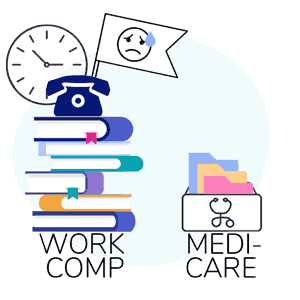CA OMFS: E/M Reimbursement vs Medicare Reimbursement

California workers’ comp allows discount networks to bleed the doctors who treat injured workers. Unfortunately for these workers and their employers, many of these financially wounded doctors are waving the white flag, and making the difficult decision to stop treating workers’ comp patients altogether.
Almost daily, we learn of another provider who decided to quit treating injured workers, because doing so is financially unsustainable in the long term. Many providers take a loss every time they treat a workers’ comp patient, for three primary reasons:
- The extraordinary administrative burdens associated with workers’ comp treatment,
- Preferred Provider Organization (PPO) and Medical Provider Network (MPN) reductions demolishing revenue
- Inadequate and poorly enforced payment regulations that incentivize payers to improperly reimburse providers
In theory, California’s Official Medical Fee Schedule (OMFS) takes the administrative burden into account by establishing reimbursement rates at 134.22% of Medicare rates. But in practice, providers are paid according to an Unofficial Medical Fee Schedule (UMFS), which falls very short of the OMFS rates.
For example, take the extremely common evaluation and management (E/M) procedure codes, which most doctors bill when treating an injured worker. The reimbursement data below for daisyBill clients demonstrates that providers receive, on average, only 104.7% of the amount allowed by Medicare for these E/M codes — not enough for a practice to keep the lights on.
Physician Fee Schedule OMFS vs Medicare Reimbursement
In 2019, California fully aligned its OMFS reimbursement rates for Physician Services with Medicare reimbursement rates. Specifically, California now uses both of the following Medicare values to calculate Physician Fee Schedule reimbursement rates:
- Medicare Relative Value Units (RVUs), and
- Medicare Geographic Practice Cost Indices (GPCI) by locality
To calculate the actual dollar amounts paid to physicians for treating injured workers, California adopts a higher Conversion Factor than the Conversion Factor used to calculate Medicare reimbursements. To compare OMFS reimbursement rates to those of Medicare is as simple as calculating the difference between the two Conversion Factors.
The table below shows the Medicare and OMFS Conversion Factors for the last four years, along with OMFS rates as a percentage of Medicare rates. As the table shows, since 2019 the California OMFS has attempted to reimburse physicians at significantly higher rates than Medicare.
Year |
Medicare Physician Conversion Factor |
California Physician Fee Schedule (OMFS) Conversion Factor |
California Physician Fee Schedule % of Medicare |
2019 |
36.0391 |
45.8513 |
127.23% |
2020 |
36.0896 |
46.7900 |
129.65% |
2021 |
34.8931 |
45.8700 |
131.46% |
2022 |
34.6062 |
46.4500 |
134.22% |
But in 2022, rather than receiving the OMFS rate of 134.22% of Medicare rates, workers’ comp providers are paid the “UMFS” rates — which our data show is 104.7% of Medicare rates, for E/M services.
Below, we compare the abysmal amounts received by California workers’ comp providers for E/M codes to the amounts allowed by Medicare for the exact same services. Our data reveal the real-world UMFS rates our providers receive for each E/M procedure code (the final column expresses the UMFS rates as a percentage of Medicare rates).
The data below represents 2022 dates of service, and the respective payments received for each E/M service.
Procedure Code |
Bill Count with Procedure Code |
OMFS Reimbursement Due |
Reimbursement Paid |
OMFS Balance Due |
Reimbursement Percent of OMFS Rate |
Reimbursement Percent of Allowed Medicare Rate |
99202 |
296 |
$31,713 |
$27,049 |
$4,664 |
85% |
114.09% |
99203 |
5,531 |
$927,542 |
$790,972 |
$136,570 |
85% |
114.09% |
99204 |
10,680 |
$2,637,648 |
$2,065,703 |
$571,945 |
78% |
104.70% |
99205 |
5,733 |
$1,877,342 |
$1,421,107 |
$456,235 |
76% |
102.01% |
99211 |
245 |
$8,868 |
$7,773 |
$1,095 |
88% |
118.12% |
99212 |
2,423 |
$206,504 |
$170,273 |
$36,231 |
82% |
110.06% |
99213 |
39,721 |
$5,405,629 |
$4,396,928 |
$1,008,701 |
81% |
108.72% |
99214 |
82,935 |
$15,859,577 |
$12,242,106 |
$3,617,472 |
77% |
103.35% |
99215 |
16,384 |
$4,436,261 |
$3,213,161 |
$1,223,100 |
72% |
96.64% |
Total |
163,948 |
$31,391,084 |
$24,335,073 |
$7,056,012 |
78% |
104.70% |
California employers, be advised that your dollars are enriching PPOs and other middleperson entities, which siphon employer funds meant to cover workers’ injuries.
All employers should be outraged that these discount entities "keyed” $7 MILLION dollars away from the doctors that heal injured workers (Recently, Broadspire exposed precisely how networks and claims administrators work in tandem to implement the UFMS.).
The Cost to Treat an Injured Worker
Any physician can calculate the administrative costs associated with treating an injured worker, and conclude that those costs far (far, far, far) exceed those required to treat a Medicare patient.
The following are the steps necessary to treat an injured worker in California, with each step representing paid person-hours and other administrative expenses incurred by the practice:
- Contacting the claims adjuster to obtain all the injury claim information required to submit the bill (Practice staff can expect either to be on hold for quite a while, or to leave multiple unanswered voicemails for the adjuster.)
- Determining whether the physician is in the employer’s MPN (Good luck wading through these 2,470 Monetized Provider Networks, put in place to reduce provider reimbursements.)
- Submitting a Request for Authorization (RFA) to the employer for every recommended treatment, prescription, DME, etc. (There are no RFA fairies; this is a labor-intensive requirement.)
- Waiting for the employer to respond to the RFA with a Utilization Review decision listing the treatment the employer approved (Nope, no UR fairies to sort through these decisions and schedule the injured worker for the approved treatment.)
- Treating the injured worker (This is the only step that’s similar for workers’ comp and Medicare.)
- Completing the extensive required reports (Medicare does not require the DWC-100, PR-2s, PR-4, etc.)
- Submitting the bill with the required reports (Specialized workers’ comp billing technology is required, since Medicare bills do not require reports. Without specialized billing technology, workers’ comp bills and reports must be sent in the mail — an extremely labor intensive undertaking that decreases the likelihood of receiving payment.)
- Waiting 45 - 60 calendar days for payment for non-electronic bills, or 15 working days for electronic bills, which require specialized software to generate (This is an eternity compared to Medicare, which deposits the reimbursement directly into the practice account within days of receipt of the e-bill.)
- Receiving payment in the form of virtual credit cards that charge a processing fee of 3% - 5%, or an Electronic Funds Transfer (EFT) payment with a “convenience fee” (Nope, there are no fees when Medicare pays a doctor.)
- If necessary, submitting Second Review appeals to dispute inaccurate reimbursement, and potentially paying $180 to file for Independent Bill Review (IBR) to pursue correct reimbursement (Medicare accurately pays providers, whereas daisyBill clients have collected almost $100 million from appeals sent to dispute incorrect payments.)
Other than treating the patient, Medicare providers needn’t worry about any of the steps above, which collectively drain vast amounts of time and resources, and require highly knowledgeable, dedicated staff. The long list of additional administrative tasks required to treat an injured worker costs far more than 104.7% of the Medicare reimbursement.
Moreover, providers are overwhelmed with the chaos of trying to run post-pandemic practices, as it is proving nearly impossible to maintain the administrative staff necessary to meet the unique demands of workers’ comp.
How long can this go on?
daisyBill has the technology and expertise to make workers’ comp work better. Reach out to see how we can help your practice obtain fast, correct reimbursement for treating injured workers.
LET’S TALK
DaisyBill provides content as an insightful service to its readers and clients. It does not offer legal advice and cannot guarantee the accuracy or suitability of its content for a particular purpose.

.gif)


